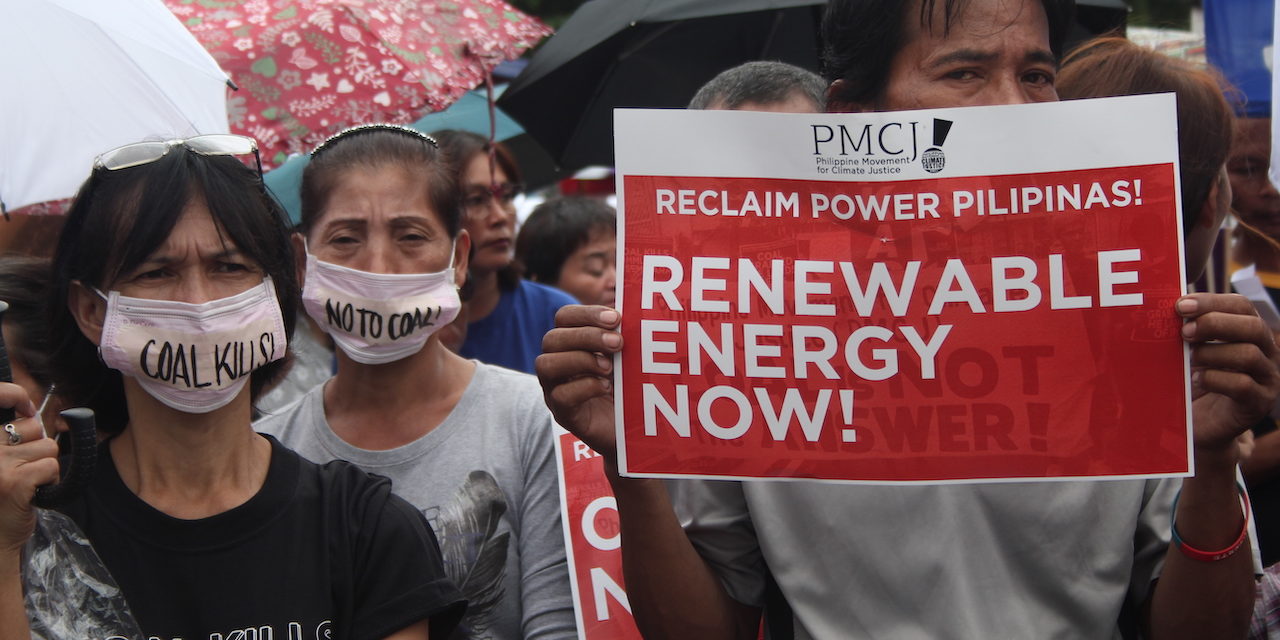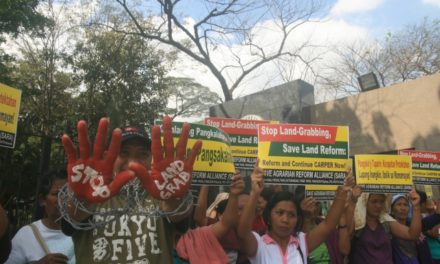About 150 activists, community leaders, and climate justice advocates from various climate networks and people’s movement marched from the University of Santo Tomas to the Mendiola Peace Arch, and were joined by residents of Barangay 105, the local community affected by Rock Energy International Corporation’s coal stockpile located in Happyland, Tondo, Manila.
This is part of the nationally coordinated actions for Global Reclaim Power 2016[i]. The Reclaim Power 2016 October Days of Actions kicked off with a sign-on statement to demand all governments of the world to make a swift and just transformation of energy systems — “from fossil fuel and dirty energy dominated systems, towards clean, renewable and democratic energy systems that ensure universal access for people and communities.”
The Philippine Movement for Climate Justice (PMCJ) issued the following statement:
COAL IS NOT THE ANSWER
DEVELOPMENT NEED NOT BE DIRTY
Today, October 10, while various countries around the world will mobilize for the Global Reclaim Power, the Philippine Movement for Climate Justice is also mobilizing in major cities in the Philippines to call the attention of the Duterte Administration that the continuing policy of coal as fuel for development contradicts with the change the Filipino people would want. This kind of development is unsustainable and runs against the welfare of the people. In fact, it will eventually kill many Filipinos. Let us be reminded that the country’s right to develop stipulates the responsibility that this development must be also sustainable, equitable, and ensures the common good of its people.
As we are asserting our collective rights today, our rights for clean air and water, our rights for sustainable future and a stable climate, the world climate system has already echoed a resounding alarm that it has already passed the 400 parts per million (ppm) of carbon dioxide GHG concentration in the atmosphere. Some scientists said that it will definitely stay at that level at a longer period of time. It will have devastating consequences for many countries all over the world for it would mean exacerbation of climate impacts like droughts and strong typhoons as known manifestations of extreme weather events, sea level rise, and destruction of biological and biodiversity systems. These will have extreme consequences in agriculture, health, and environment, and all other earth’s processes. Alongside this news are death and destructions happening in various parts of the world due to climate change. In the Pacific, hunger and drought followed the most intense El Niño year. The intensification of El Niño due to climate change has triggered long and extreme droughts in the Philippines resulting to billions of pesos of crops damage, hunger, and death. The other extreme, typhoons Megi and Meranti, some of the strongest in modern weather history, lashed Taiwan, China and the Philippines’ Northern Islands, precipitating landslides and causing the dozens of deaths.
Other countries in the world have its share of devastations. In Indonesia, twenty were killed as torrential rains hit Java. In Nepal, seven people lost their lives in torrential rains and subsequent landslides. Scientists have warned of the sinking of the Mekong Delta. At least 133 people were killed, and over 107,000 people displaced after flooding in North Korea, while in Russian Siberia, which has been affected by major forest fires, residents have petitioned the Russian President, complaining of severe carbon monoxide poisoning. In India, water riots have broken out in drought-stricken regions and four environmental defenders were killed as police opened fire on a protest against a coal mine in Hazaribagh. Ajit Tyagi, the President of the Indian Meteorological Society, warned of the risk of further heat waves in India, asserting that heat waves claim over 3,000 lives a year.
In the African continent, in the country of South Africa, drought has led Kruger National Park to cull 350 hippos and buffalos citing concerns over the animals’ suffering. In Mozambique, up to 1.5 million people face food insecurity as a result of drought.
In North America, Greenland’s ice cap is disappearing far more rapidly than previously estimated and open water is nearing the North Pole—a symptom of a rapidly warming Arctic. And in the Caribbean, Hurricane Matthew became a record breaking category of five, smashing into Haiti and soaking Colombia. NOAA scientists have reported a ‘massive die off’ of coral reef in the Gulf of Mexico.
The year 2016 is another intense year of climate impacts. The only different it has of the previous year is that the climate impacts are more pronounced and widespread and almost all the perceived impacts are happening all at once. This is now the consequence of unabated carbon emissions which science has already forewarned that emissions have to be immediately cut. At the heart of this problem is the continued burning business as usual of fossil fuel particularly coal.
We, the Filipinos know too well the impacts of climate change. Living in a country being visited with an average of 19-22 typhoons a year, and unprecedented droughts, any global temperature increase will always be disastrous for the Philippines and all vulnerable countries. This urgency of survival for the vulnerable country is strongly linked to the aspirational call in the Paris agreement to exceed 1.5 degrees Centigrade the average global temperature increase. It is the only scientifically achievable average that any vulnerable countries may survive. However, with the year 2016 now at 400 ppm, the chances not to breach the 1.5 have become narrower and shorter.
There is too much dilly-dallying of most countries to seriously commit to ambitious emission cuts. Burning of coal, at the rate of building coal-fired power plant still continues business as usual. While Europe and US are starting to shut down coal plants, Asia on the other hand has become the epicenter of coal expansion of the world. Investments on coal development have only transformed the region into a global coal furnace unperturbed of the climate crisis. Irresponsible lending and financing still characterizes the capital market in energy development. Various international financial institutions (IFIs) led by World Bank, local banks, export credit agencies (ECAs) still invest in coal. In Southeast Asia, the Philippines sits in the powder keg of coal expansion with no less than 36 coal plants with 63 boilers are now in the pipeline. World Bank has been funding 20 coal plants in the Philippines.
The Duterte government no longer has any profound bases of continuing coal power plants. What it has is a deep moral obligation to its people not to continue those in the pipeline and lead the country to shift to renewable energy. Coal is the most dirty and harmful energy. It is the number one GHG emission and the cause of global warming. All over the world, communities living near coal plants suffer from health and environmental hazards. The Filipino communities living near these coal plants wanted all these plants stopped. They have no place to go and their history are in these places. The communities have already felt the observable impacts these plants have caused. According to the Harvard University led study on the impacts of coal plants in the Philippines on the health, the study evaluated 13 operational coal-fired power plants in the Philippines with a combined installed capacity of 3,799.10 megawatts (MW), as well as the potential impacts of plans to build 29 new coal-fired power plants with a total capacity of 11,700 MW, which could dramatically increase levels of sulfur dioxide (SO2), nitrogen oxide (NOx) and PM2.5 emissions. If the new power plants are to be developed, premature deaths may rise up to 2,410, or more than double the current number of people dying from coal-related pollution in the Philippines. Also, the fear of these coal plants becoming stranded assets will surely affect the future energy security of the country.
The Duterte Administration stands now at the crossroads of the health, environment, country’s energy security and the climate crisis these coal plants will trigger. While it is true that it has inherited the coal dependent energy development program from previous administrations, yet it does not mean that he is bound to continue this ill-fated energy policy. He can do better than his predecessors. He is the most powerful official in the government today and given the people’s mandate, he can extricate the Philippines from the looming doomsday if he chooses to do so. If he is truly serious that his platform serves the interest of the people, then continuous use of coal is not the answer.
Photos by Galileo de Guzman Castillo. To see the complete photo album, please go to: https://www.flickr.com/photos/focussouth/albums/72157674913404806
[i] Reclaim Power is a collaboration between movements, local groups, networks, and NGOs to strengthen the links between energy and climate struggles. Reclaim Power is a collective effort to draw global attention to the climate crisis and the urgency of transforming energy systems. It is about taking a moment for movements, communities, people to express and experience global solidarity in our common struggles. It is about organizing actions and reaching out to as many people, communities and movements in as many countries as possible to raise awareness, deepen understanding, and provide opportunities for people to get directly involved. This October 2016 Reclaim Power aims again to inspire and mobilize people from all walks of life in many countries for a variety of actions, and continue to contribute to building a powerful global movement for energy transformation. It will build on the momentum generated by the Break Free from Fossil Fuels initiative earlier this year.
For more information about Reclaim Power and the sign-on statement, please go to: http://reclaimpower.net/









